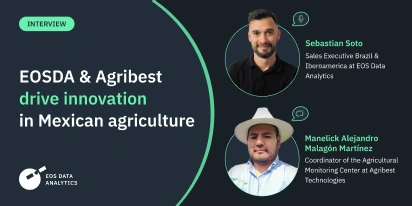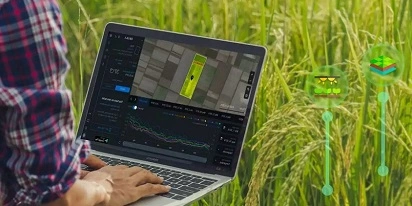
How Remote Sensing Technologies Help In Viticulture
Cultivation of vines requires careful exploitation of soil and attention to every smallest detail affecting the growth of grapes. Depending on the end purpose of grapevines, viticulture studies suggest various activities for their successful management. Practices like irrigation, site selection, and canopy management can be performed more effectively with the use of modern technologies such as remote sensing.
In this interview, Lidia Lelechenko, Account Executive at EOS Data Analytics, shares her take on how remote sensing helps address current viticulture challenges and reach sustainability in grapevine cultivation. Lidia holds a Master Degree in Viticulture, Winemaking & Marketing obtained in École supérieure d’agricultures d’Angers and possesses a unique outlook on the issue.
Lidia, What’s The Current State Of The Viticulture Market, And What Problems And Challenges It Currently Faces?
Climate change has been negatively affecting the entire chain of winemaking processes and, as a result, the total size of vineyard surfaces around the world. Rising temperatures causing earlier ripening and higher concentration of sugars lead to higher alcohol potential. Water scarcity and droughts force viticulturists in Argentina and South Africa to reduce their operations.
Some viticulturists turned to smart production management, which helped stabilize the total vineyard area in the EU. As a result, during the last twenty years, we’ve been witnessing a slight decline in the total worldwide area of vineyard surface: from 7.8 million hectares in 2002 to 7.35 mha in 2021 . But it has all chances to become much more noticeable in the coming years.
To withstand climate change and the negative consequences it brings, the industry is obliged to change and adapt, which often requires investments of time and money not everyone is able to afford.
The most effective way to improve the situation is to turn to precision agriculture practices that help stimulate vegetation and control yields. The size of the global precision viticulture market is estimated to grow by 9.2% up until at least 2027 .
Modern technologies leveraged in precision viticulture practices to improve grapevine productivity and yields include driverless machinery, guidance systems, drones, and remote sensing. However, despite the efforts of various governments, insurance companies and advisory businesses to promote the adoption of such technologies, the underestimation of its potential and lack of technical expertise demonstrated mostly by old-world winemakers suppresses further market growth.
How Much Is Remote Sensing Adopted In Viticulture? What Are The Main Factors Driving This Process?
I have witnessed the growing scientific interest in this topic throughout at least the last two decades.
The most popular area of research is figuring out how satellite data can help understand the influence of terroir on wine. Nowadays, various techniques can be used to process such data: object-based analysis, hyperspectral analysis, topoclimatology, spatiotemporal analysis, and more.
For instance, object-based analysis enables the investigation of various grapevine characteristics and metrics via different spectral images of it. In EOSDA Crop Monitoring, it is implemented through index analysis, such as NDVI, which calculates the intensity of vegetation in the given spot. And spatiotemporal analysis allows farmers to monitor the status of their vines continuously and notice important changes, such as crop damage caused by pests or frost, in a timely manner.
Thanks to these scientific efforts and the fact that satellite technologies are becoming increasingly affordable, remote sensing has been gaining popularity among viticulturists. I don’t have exact numbers on how exactly it is widespread as of 2022, but even the winegrowers preferring to rely solely on their instincts find it increasingly difficult to withstand the opportunity to lower their production costs by at least 20-30% with modern technologies.
What Benefits Does Remote Sensing Bring To The Viticulture Farmers In The Short-Term And Long-Term Perspectives?
In the short term, perspective grape growers can track the health of their vineyards on a daily basis with much less effort. Grape leaves are pretty sensitive to various threats and therefore can inform farmers about upcoming troubles via color change.
Classy methods like planting rose bushes at the beginning of the vine row, as they reveal potential hazards even earlier than the vine, are beautiful without any doubt, but getting such data about crops with a click of a button is even more effective.
In the long run, it also brings stability and confidence to winemakers: one of the important features the wine should possess to become successful and notable (unless we are talking about experimental winemaking) is having a similar taste year in and year out. The same taste can’t be guaranteed due to multiple factors, but it is the quality of grapes that builds the fundament of the future wine. When grape growers are sure about the quality, they can as well be sure at least half of their job will be done right.
Join the EOSDA Partner Program
Do You Have Any Real-World Examples When Remote Sensing Helped Improve Viticulture Practices?
The main reason grape growers turn to crop monitoring and management platforms like EOSDA Crop Monitoring is the improved effectiveness of various tasks that must be done throughout the growing season, such as field monitoring, scouting, or optimal use of irrigation or fertilizers.
Science papers, on the other hand, can highlight more specific cases of remote sensing usage in viticulture.
For instance, in 2017, northern Italian vineyards suffered from late frost . Remote sensing technologies were used to assess the damage it caused and the time grapes needed to recover by utilizing specific vegetation indices. And although the collected data was insufficient due to the sky being often covered by clouds during the survey period, the method was proved as cost-effective and informative enough for further utilization.
Similarly, remote sensing can also be used to study the effect of heat waves on grapevines. One study found medium-resolution data from the Sentinel-2 satellite can be informative enough, even though when talking about vegetation indices, the calculations might go sideways due to the presence of interrows on the grapevine fields . This data turns out to be helpful in tasks like canopy management, calamity alleviation, and others.
The question I find most intriguing is how we can further process satellite data to provide grape growers with advanced insights such as yield prediction or harvest monitoring.
In more sophisticated cases, technologies like artificial intelligence and machine learning can be used. Some researchers even aim to create solutions allowing phenotyping the most productive grapevine cultivars that can withstand climate change .
How Can EOSDA Solutions Help Boost Viticulture Sustainability With Its Solutions?
The vision of EOS Data Analytics is to make space tech a global driver of sustainability on Earth. The way we build our products revolves around this idea and our commitment to the United Nations’ sustainable development goals. Better pesticide and water management, precise tracing of vegetation development, timely detection of crop threats together, and accurate prediction of yields – all of these advantages together help reach sustainability in any agricultural activity, including viticulture.
What makes viticulture stand out is the fact that it allows food production with potential carbon neutrality. In addition, sustainable grape production contributes to climate change less intensely than other foods. Hence boosting sustainable viticulture is a priority task in our shared goal of reaching food security.
Finally, all winemaking countries have certain regulations on viticulture. In France, for example, each zone of wine production implies following specific rules for the wine to have its appellation granted and indicated on the label. Some of these requirements are related to the vineyard yield, type of soil, and quantity of allowed irrigation techniques. Such things can be tracked and confirmed with satellite data, helping winemakers focus on what they love most – produce the best wine they can imagine.
What Are EOSDA’s Plans Regarding Viticulture Farming Development?
Apart from continuously improving our platforms and tools and launching the EOS SAT-1 to take complete control over the data we process and provide to our clients, we have special plans for the viticulture industry.
I take precision viticulture closely to heart as I know how crucial it is to ensure every step of the winemaking process is done correctly. It defines the taste of wine in the glass, and the main goal of winemakers is to make this glass the most special and enjoyable for their consumers.
Moreover, I believe wineries adopting satellite technologies in their daily practices contributes not only to the improvement of their wine quality but also invents new ways to resist climate change, follow innovative wine market trends, and ultimately reach production sustainability through progress and openness.
I’ve seen many times how sensitive and caring grape growers can be toward their vines. EOS Data Analytics is here to help and speak your language. Do not hesitate to reach out to us and boost your path to wine stars with us.
About the author:
Lidiia Lelechenko holds a Master Degree in Viticulture, Winemaking & Marketing obtained in ESA (École supérieure d'agricultures d'Angers). She has over 6 years of experience in various roles related to SaaS solutions sales and research activities in sensory analysis. Currently, Lidiia is responsible for strengthening EOSDA presence and recognition on European markets as an Account Executive.
Recent articles

Transition Guide From Sentinel Hub EO Browser To EOSDA LandViewer
Need an EO Browser alternative that’s just as familiar but more flexible? EOSDA LandViewer offers free recent imagery, a vast satellite data archive, and advanced analytical tools.

EOSDA & Agribest: Driving Agtech Growth In Mexico
In this insightful interview, Agribest shares how its collaboration with EOSDA is shaping Mexico’s agricultural future, with a focus on profitability, sustainability, and technology.

Top Ready-Made Agriculture Tools & Softwares for 2025
Agriculture softwares are silent partners in the field, working tirelessly behind the scenes to support farmers with insights and precision to cultivate sustainable agricultural ecosystems.